| cosam.org |
Observation Log - 29/10/2004
| Subject: | Saturn, Jupiter, Venus, Mars |
| Seeing: | Poor |
| Light: | Poor |
| Location: | Home (front landing) |
Equipment
| Scope: | Meade LX90 |
| Other: | TeleVue 2x Barlow, Meade LPI |
Comments
One of my reasons for getting a Barlow was to allow me to make better use of the LPI (Lunar Planetary Imager) which came with the LX90. Planetary images are rather small using this imager alone - magnification is similar to a 6mm eyepiece. Using the Barlow I'd be able to double or triple this, making some larger images.
I took a set of about 30 frames of Saturn at double magnification before making two runs of 50 and 70 frames with the Barlow in front of the diagonal. Stacking the last two sets produced the images below. Considering the awful seeing, and the fact that it's a first attempt, I wasn't too disappointed with the results, although there's obviously a long way to go yet!
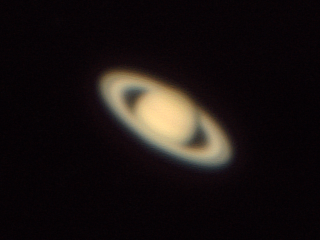 First attempt at imaging Saturn with the LPI, under pretty bad conditions. | 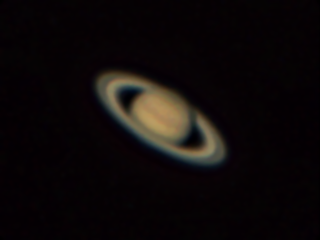 Another image, stacked from the same sources with additional processing. |
With the raw frames recorded, the clouds started drifting over again, so I took another break from observing and experimented with processing the image. [At a later date, I made the image on the right - see the astrophotography page for details.]
It wasn't until about 03:45 UT that I ventured out again. Jupiter was due to rise any time now, and I'd been looking forward to seeing this planet for myself. 20 minutes later I noticed a small speck creeping above an apartment building in the East. Was it a reflection from an antenna, or had I just gotten my first glimpse of Jupiter?
I slewed over to the spot, my eye glued to the finder. Yes! The bright speck wasn't attached to the building at all - it must be Jupiter! The first look through the 26mm Plossl was a little less exicitng than I though it'd be. The planet was still very low in the sky and only a plain, light disk was visible. Its yellowy/orange tone was distorted by the thick hazy atmosphere near the horizon. Near the disk, two smaller dots were visible - moons! They were opposite each other at almost equal distances from the planet, the line through their centres tilted a little more than 45 degrees.
By about 4:15 UT, the image was getting clearer and a dark band was visible just above the equator. Another five minutes, and a second started to come into view just below the equator, but this one seemed to fade away towards the right of the view. At 4:30 UT, I switched to the 26mm Plossl to see if that would reveal any extra detail. It didn't help much, but I did notice yet another moon way off to the bottom right of the eyepiece. And what was this? One of the moons near the planet seemed to have divided! What had appeared through the haze as one moon, was in fact two. They looked very similar to a quite tight double star.
4:50 UT: The bands were now also visible at 400x, and the "split" moon was clear enough for me to confirm the two parts as separate objects. The image was gradually getting clearer and clearer, so at about 5:15 UT I made a couple of sketches, from which the images below are derived. The moons are numbered as (1) Europa, (2) Io, (3) Ganymede and (4) Callisto.
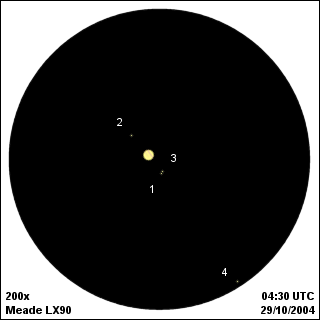 Jupiter as seen through the 9.7mm Plossl. | 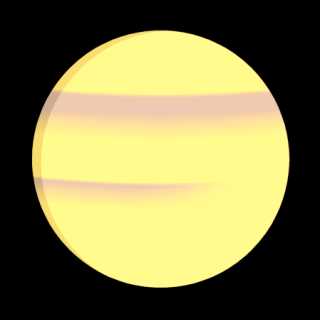 Sketch of the surface detail visible. |
Having waited up this long, I thought I might as well wait that little bit longer and have a look at Mars, which became visible (after rising behind a building) at 5:45 UT. Compared to the other planets, the disk was tiny, but the red colour was very obvious, even through the morning haze.
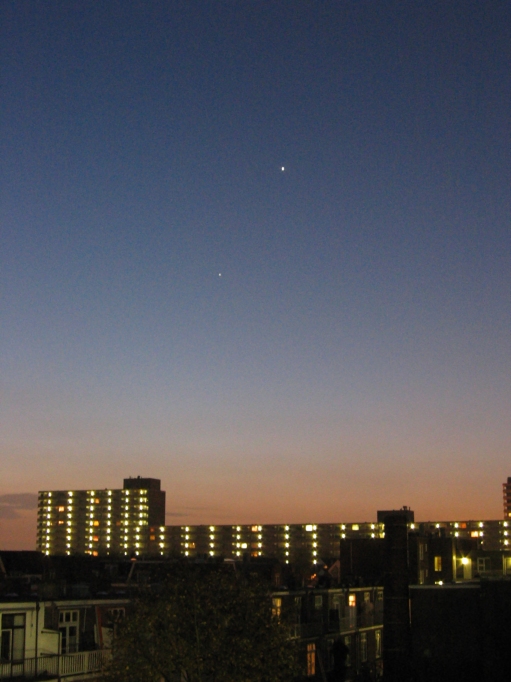 Venus and Jupiter at dawn, just before turning in (click for a larger image). |